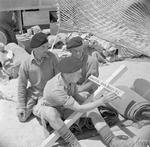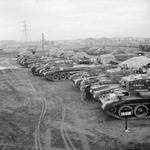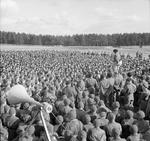John Morris
| Surname | Morris |
| Given Name | John |
| Born | 30 Jun 1911 |
| Died | 5 Mar 2008 |
| Country | United Kingdom |
| Category | Photography |
| Gender | Male |
Contributor: David Stubblebine
ww2dbaseThough of Scottish decent, John David Lamont Morris was born in South East England in the Berkshire town of Reading in 1911, son of a seedsman. When he was young, David, as he was known, and his family moved back to Scotland to the area around Dundee in the east where David attended Grove Academy. His wished to train as an engineer but the death of his father required him to take up work to help support his mother and sister. He took the job of an apprentice photographer in Edinburgh, Scotland and later set up his own photographic business, conducting mainly commercial and industrial photography. He met and married Rosalind Gill, a nurse, and they had two children, David and Lesley.
ww2dbaseThe outbreak of the Second World War gave Morris one of the greatest "scoops" of his photographic career. In October 1939, he was on a business trip to the Borders region of Scotland when he heard excited news about a German bomber having been shot down nearby. Taking his heavy camera equipment, he climbed 1,000 feet into Scotland's Lammermuir Hills and took a photograph of the wreckage of a Heinkel He-111, among the first German bombers to be shot down over Britain during World War II and the first to crash on land allowing an inspection of the aircraft. Over the next few days, photographs of that bomber were published in every national newspaper in the United Kingdom.
ww2dbaseShortly thereafter, Morris volunteered for military service. After basic training in the British Army, he was initially posted into the Royal Engineers but soon was transferred to the newly-formed Army Film and Photographic Unit. His first overseas posting was to Durban, South Africa, as part of the force preparing to invade Madagascar, which was, at the time, held by the Vichy-French.
ww2dbaseSome of the best descriptions of the military action in Madagascar are described by K.C. Gander-Dower in his book Into Madagascar. Although a truce was quickly signed between the Vichy and British forces, some of the outlying French garrisons were not informed and fighting continued. Writing about a particularly violent confrontation between Allied and Vichy troops at Mahajanga in September 1942, Gander-Dower says:
ww2dbase"Here it was that a War Office Sergeant Photographer distinguished himself by bringing this persistent battle to an end. While everyone else sensibly took cover, he advanced down the road waving one of the yellow silk scarves which were worn in this action for identification purposes. Three times he had to fall flat on his face to dodge bursts of machine-gun fire; three times he got to his feet and brandished his scarf again. The third time the symbol was recognised, firing ceased, and the Sergeant had brought the battle of Mahajanga to a reluctant end. Unfortunately, there was no-one there to take his photograph."
ww2dbaseEven without a photograph, Sergeant J.D.L. Morris was "mentioned in despatches" and the yellow scarf was brought home where it remains a family memento to this day.
ww2dbaseFrom Madagascar, Sgt Morris was posted to Kenya where he was quite happy photographing the scenery and colorful residents. After the successes in North Africa, Morris and two others from the Photo Unit were transferred back to England.
ww2dbaseWhen he arrived home, Sgt Morris hugged his wife so hard that he managed to crack one of her ribs! He was posted to the War Office in London where he traveled on assignments throughout southern England for most of 1943. He took photographs of massive concrete boxes under construction and what looked like detached houses and shops. Unusually, he was not permitted to keep copies of any of his 1943 pictures; the undeveloped film was required to be submitted directly to the War Office. He later learned the concrete boxes were the components of the Mulberry Harbors for the Normandy Landings and the houses and shops were pumping stations for Operation Pluto, the pipelines from England to France that would deliver millions of gallons of fuel to the Allied Forces following the D-Day landings.
ww2dbaseIn early 1944, Sgt Morris was assigned as staff photographer for General Bernard Montgomery, soon to become Supreme Commander of the Allied Land Forces for the invasion of the European continent. Sgt Morris stayed on Montgomery's staff until the end of the war, travelling from southern England, to the Normandy Beaches, across northern France, through Belgium and Holland, and finally into Germany. His photographs include many pictures of Montgomery himself, as well as a long list of top officials who met with Montgomery during some of the most important moments in the European war including King George VI of the United Kingdom, Winston Churchill, General Dwight Eisenhower, and General Jan Smuts.
ww2dbaseIn April 1945, Sgt Morris and his camera were among the first British troops to enter and inspect the camp at Bergen-Belsen. He thoroughly documented the condition of the prisoners, including the many dead, and the unspeakable living conditions in the camp. Many of his photographs, though gruesome, became standard stock photos representing the Holocaust itself.
ww2dbaseA short time later, launching sites for Germany's V-2 rockets were overtaken and again, Sgt Morris and his camera were along to record the discoveries. [Later, in October 1945, British engineers reassembled three V-2 rockets at the former Krupp weapons proving grounds in Cuxhaven, Germany and launched them for demonstration purposes. Sgt Morris was there as well to photographically capture these tests.]
ww2dbaseIn between the discovery of the launch sites and the test firings, in May 1945, Sgt Morris was on hand at Field Marshal Montgomery's headquarters at Lüneburg Heath, Germany as Montgomery accepted the surrender of German forces in northwest Europe.
ww2dbaseOnce the war in Europe ended, Morris expected to be transferred to Burma so he submitted to all the required inoculations but had such a reaction that he landed in the hospital for 10 days. Despite his preparations, the war ended before Sgt Morris left for Burma.
ww2dbaseAs Sgt Morris was preparing to be discharged, he sat for a portrait with Montgomery that the Field Marshal signed as a memento for the sergeant. Morris also received a certificate of appreciation signed by the Field Marshal.
ww2dbaseBack in civilian life, David Morris returned to Edinburgh where he found work as a press photographer for the "Glasgow Herald" and "The Bulletin." In time, he bought a partnership in the Edinburgh firm of A.G. Ingram & Company whose business involved a broad range of photographic work, including commercial and industrial work.
ww2dbaseIn 1976, David Morris retired and emigrated to Tauranga, New Zealand. His large collection of wartime photographs and other memorabilia were packed into a large suitcase that went with him to New Zealand. Later in his life, Morris sent the suitcase back to Britain with his son. In 2008, John David Lamont Morris passed away at the age of 96. His suitcase of photographs survives and remains a prized family possession.
ww2dbaseSources:
David Morris (son)
Louise Fox (granddaughter)
Imperial War Museum
Scotland's History (sath.org.uk)
Wikipedia
ww2dbaseSpecial Thanks: The author wishes to express a special note of thanks to Louise Fox, David Morris' granddaughter, for her help and encouragement in compiling this personal history. Special thanks also goes out to the Morris family who provided many of Sgt Morris' photographs and gave permission for them to be posted at the World War II Database.
Last Major Revision: Dec 2019
Photographs
 |  |  |
Photographs Taken by John Morris
 |  |  |  |
John Morris Timeline
| 30 Jun 1911 | John David Lamont Morris was born in Reading, Berkshire, England, United Kingdom. |
| 5 Mar 2008 | John David Lamont Morris passed away. |
Please consider supporting us on Patreon. Even $1 per month will go a long way! Thank you. Please help us spread the word: Stay updated with WW2DB: |
Visitor Submitted Comments
All visitor submitted comments are opinions of those making the submissions and do not reflect views of WW2DB.

- » Wreck of Teruzuki Found (27 Jul 2025)
- » USS Orlean's Bow Found (22 Jul 2025)
- » The Emperor of Japan Planned to Honor WW2-era Japanese POWs in Mongolia (4 Jul 2025)
- » US State Lawmaker John Winter Caught Using Racial Slur "Jap" and Apologized (11 Jun 2025)
- » US Government Plans to Purge WW2 Information (17 Mar 2025)
- » See all news
- » 1,182 biographies
- » 337 events
- » 45,119 timeline entries
- » 1,249 ships
- » 350 aircraft models
- » 207 vehicle models
- » 376 weapon models
- » 123 historical documents
- » 261 facilities
- » 470 book reviews
- » 28,412 photos
- » 365 maps
Winston Churchill, 1935
Please consider supporting us on Patreon. Even $1 a month will go a long way. Thank you!
Or, please support us by purchasing some WW2DB merchandise at TeeSpring, Thank you!
19 Apr 2024 05:18:30 AM
Good afternoon. Thank you for a most interesting read about Sergeant Morris. I'm currently finishing a book about 21st Army Group and would be grafetuyl to be put in touch with a member of his family. Naturally, i had already collected a number of his pictures from teh Imperial War Museum and would bery much like to include a captioned image to highlight his role in the visual record. The book is for After the Battle (now part of Pen & Sword Books). Many thanks in anticipation.